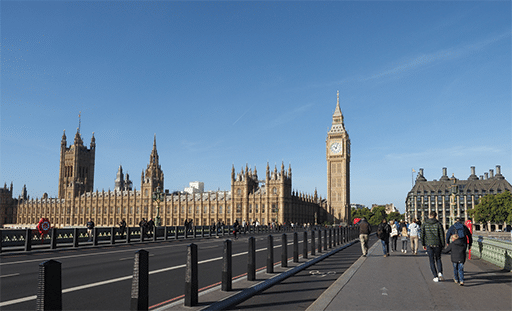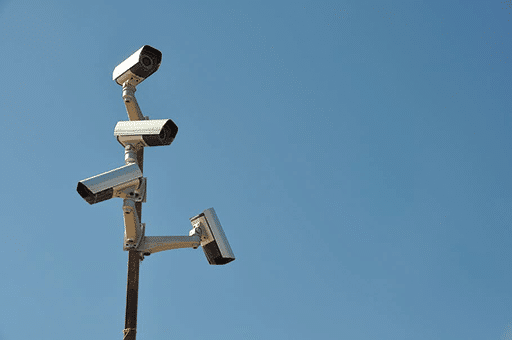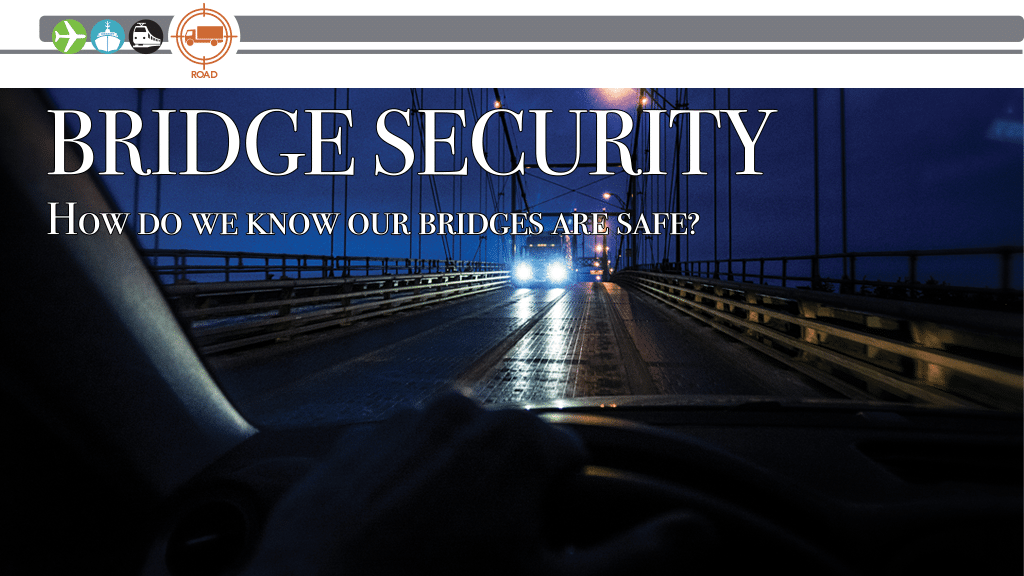There are approximately 600,000 bridges in the United States. With the growing number and intensity of domestic and international terrorist events in the post 9/11 world, more and more is being done to try to protect them. Terrorists attack critical infrastructure where human casualties and economic consequences are likely to be substantial. Because bridges are an integral cog in the transportation network with a bearing on human lives and economic activity, they are a likely terrorist target. Bridges are easily accessible to the public, have minimal security and provide the opportunity for a high number of casualties and injuries.

An al-Qaeda training manual found in 2000 explicitly endorsed “Blasting and destroying bridges leading into and out of…cities.” A bridge or tunnel collapse during rush hour traffic might kill hundreds or thousands. Overall estimates of the cost to replace a major long-span bridge on a busy interstate highway corridor in the United States could cost billions of dollars, and hamper or divert commerce, industry, agriculture, and investing both locally and nationally.
Secure and Protect
Given their importance, and the potential economic, psychological and human consequences of such attacks, it is crucial that traffic and railway bridges are properly secured and protected from disruption. However, doing this can be challenging. There are no easy security measures to guard against terrorist attacks on bridges. With bridges, the roadway or railroad track has to remain open to allow traffic flow. Bridges are exposed on all sides, making them vulnerable from above, below and at the water’s edge.
Bridge security, like security for any infrastructure asset, includes a broad range of issues that must ensure that adequate measures are taken to protect the asset and the people and goods that utilize the asset. According to a panel formed by the Federal Highway Administration (FHWA) and the American Association of State Highway and Transportation Officials (AASHTO) the consequences of a terrorist attack on a bridge can be expressed as follows:
• Threats to the integrity of the structure (e.g., resulting in replacement of the facility or major repairs).
• Damage that inhibits the structure’s functionality for an extended period of time, such as closure of the facility for 30 days or more.
• Catastrophic failure resulting from an attack based on the threats described above.
Terrorist threats to bridges can include:
• Fire (can lead to buckling of steel beams and spalling of concrete).
• Impact (can lead to damage of piers, causing collapse of the superstructure and failure of hangers, again resulting in collapse of the superstructure).
• Mechanical cutting devices (can lead to cutting of hangers, resulting in collapse of the superstructure).
• Corrosive chemicals.
• Blast or explosion (can lead to severe damage of the structure).
Today, the U.S. Department of Homeland Security (DHS) plays a critical role in bridge security. In addition, the Transportation Research Board (TRB), through its cooperative research programs, had been addressing these security issues prior to 9/11 and substantially expanded its effort after. FHWA has continued to work with TRB in this effort.
After the 9/11 attacks, FHWA started conducting onsite assessments of bridges. In collaboration with other agencies, it began evaluating these structures around the country for their ability to resist attack. There were also several independently sponsored assessment studies and security retrofit projects done at that time on major bridges.
Information gathered from all of this helped fine-tune retrofit measures and increased potential restrictions on proposed countermeasures. The original focus was on vehicle-borne charges, but the engineering assessment teams found alternative attack methods to be feasible, so where possible the researchers factored those into the development of countermeasures.
The field investigations helped identify long-term issues and focus implementation. Other issues considered by the researchers included size and weight limitations on existing structures, especially older ones; material and geometric restrictions; practical restrictions imposed by construction, maintenance and inspection; and the need to coordinate retrofit designs and hardware with those from other retrofits.
Mitigating Damage
What can be done to prevent terrorist attacks on bridges? There is a variety of countermeasures that can be used singly or in combination to reduce attractiveness and/or vulnerability, or to reduce consequences if an attack occurs. Countermeasures are often grouped into actions or technologies to deter attack, deny access, detect presence, defend the facility, or design structural hardening to minimize consequences to an accepted level.
Bridge owners and operators should consider incorporating physical security features, including traffic and pedestrian cameras, increased illumination, restricted access to critical areas, and barriers for bridge piers and pedestrian and bicycle pathways. As structurally deficient bridges are updated or replaced, public safety personnel — emergency managers, planners and others — are encouraged to work closely with engineers and inspectors during the planning stages to contribute security and emergency response considerations.
According to the Office of the Director of National Intelligence, the following observable indicators specific to bridges may create some degree of suspicion of criminal activity. Any determination of possible illicit intent should be supported by additional facts that justify reasonable suspicion. While one activity may be insignificant on its own, the indicators should be looked at “under the totality of the circumstance.” Any indicators creating a strong suspicion of violence when observed in combination with other suspicious behaviors may constitute a basis for reporting.
Watch for:
• Unauthorized persons inside restricted areas or areas not normally accessed by the public.
• Evidence of tampering, cutting or other signs of damage to the structure or its components.
• Unattended or abandoned bags, packages, containers, or other items.
• Surveillance of the bridge or its components either in person or remotely — for example, by using unmanned aircraft systems — without a reasonable explanation.
• Vehicles or water vessels loitering or illegally parked near bridges or critical components.
According to the Department of Transportation the following actions should be considered during the design phase of all structures. In general, public access to bridges should be limited to the traveled way. Example of details to consider include: locating box girder access openings away from abutments where the soffit is close to the ground; providing locking mechanisms on deck access openings; placing screens at soffit vents near abutments, and; preventing access to girder flanges and maintenance walkways at abutments.

Withstanding an Attack
Can bridges be built and retrofitted to better withstand a terrorist attack? In a study funded by the Texas DOT and seven other state transportation agencies, analytical models helped investigate cost-effective and unobtrusive design and retrofit options for a variety of bridges. The researchers collaborated with the U.S. Army Corps of Engineers and private consultants specializing in bridge design and structural response to blast loads. Vehicle bombs are the terrorist weapon of choice worldwide and are a significant concern for highway bridges. Using computer simulations and blast tests on 16 half-scale bridge columns, the researchers were able to see how these critical bridge components respond to various explosion scenarios.
Among the major findings is that the shape of a bridge column can play a large role in how well a bridge withstands blast pressure. In the experiments, circular columns decreased the blast pressure on a bridge by up to 34 percent compared to a square or rectangular column of the same size. The dimensions of bridge columns also had a major impact on the column’s capacity to withstand a close blast. Consequently, the researchers recommended a minimum bridge column diameter of 30 inches in their design guidelines.
In states prone to earthquakes, like California, the impact of the guidelines is not as significant because bridges there are already designed and built to withstand tremors from an earthquake. But in states like Texas, where there is little or no seismic activity, bridge construction may require improved column detailing. In these states, the new guidelines can make a significant difference in improving bridge safety.
U.S. Army Engineer Research and Development Center has Anti-Terrorism Planner for Bridges (ATP-Bridge) software available to provide help. It is a fast-running, engineering-level code for predicting damage to bridge components by explosive, thermal and mechanical threats. ATP-Bridge enables rapid vulnerability assessment for existing bridges and can aid designers to incorporate protective design in new construction. This software is primarily aimed at bridge engineers, but could also help law enforcement or emergency management personnel to assess likely damage to bridge infrastructure from selected human-made intentional or accidental hazards.
With this software, damage predictions are made using a combination of empirical models for localized damage and an explicit time-integration finite element code for column structural response. Models in ATP-Bridge leverage over a decade of physical testing and high-fidelity simulation. A straightforward graphical user interface allows the user to create an inventory of components and threats quickly and easily. The component types that can be modeled cover reinforced concrete (R/C) columns with circular or rectangular cross sections, R/C tower panels, steel tower panels and cables.
Surveillance
Surveillance systems for bridges flooded the market after September 11, but many states lacked guidance for choosing among them. FHWA undertook a research study to determine the latest surveillance technologies and security practices, and develop a protocol to assist in the decision-making processes.
FHWA led a Transportation Pooled Fund effort focusing on the state of current and future surveillance and monitoring technologies available both within the United States and abroad. Researchers surveyed bridge and tunnel owners about their existing surveillance and security capabilities, including their experiences with these technologies.
The research also included site visits to examine existing systems. The study produced a report, Bridge and Tunnel Security and Surveillance Technologies, and a database of available security and surveillance systems. Currently, the report is available by contacting FHWA, and the long-term plan is to make it available through the National Technical Information Service.

Smart thermal cameras with integrated video analytics can survey critical infrastructure in the tough outdoor environment that bridges exist in to keep them safe.
Princeton, N.J.-based SightLogix’s SightSensors aid bridge security challenges because they can:
• Detect movement with a high degree of accuracy in the presence of small animals, birds, flowing water or blowing debris.
• Provide early warning of intruders over massive buffer zones beyond the bridge structure itself — detecting intruders and approaching watercraft over hundreds of meters far and wide.
• Operate in complete darkness as well as glare conditions caused by the rising or setting sun, headlights, or reflections off water.
• Employ automatic stabilization to remove camera shake caused by passing trains, traffic and wind.
• Determine the exact location of the intrusion and automatically zoom PTZ cameras to follow the action in real time.
Looking ahead, surveillance and more effective detection and warning systems will help mitigate incidents. Improved designs and effective uses of new materials can help protect structures and ensure that unpreventable damage does not result in complete failure, which could cause major disruption to the economy and possibly numerous lives lost.
